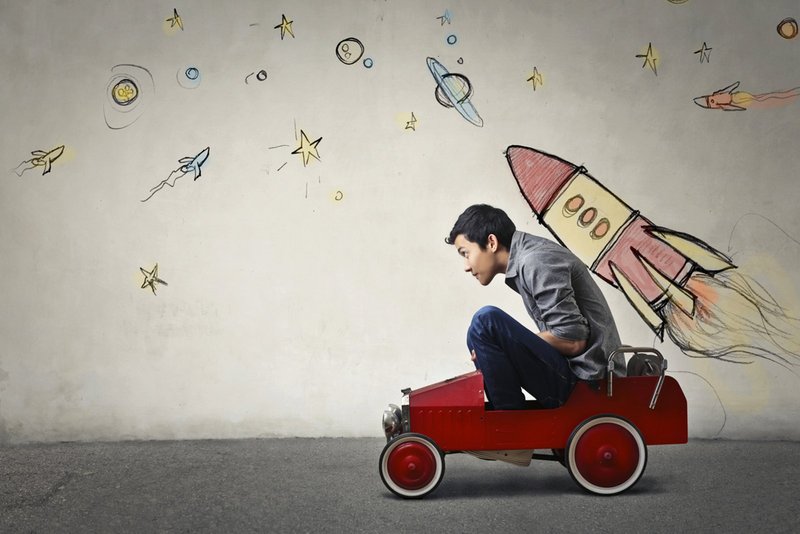
Adults want to play too
What's behind the "Kidult" trend and why it's here to stay
A commentary by Axel Gundolf
In 2020, Playmobil brought out a licensed product that instantly got my pulse racing, even as a forty-something adult: the DeLorean from the Back to the Future eighties movie trilogy. Those cult films had been an essential part of my childhood and I would have spent a whole year’s pocket money at the time to get my hands on such a toy. Playmobil had brought it perfectly to life – with real gullwing doors and even wheels that could be folded under to switch to flight mode. I was well impressed!
But, as an adult, did I really want to buy a Playmobil set? What would I even do with it? Stick it in a cabinet so I could look at it and get all sentimental about the past? Or let my children play with it, even though they’d never truly understand why Dad keeps saying “flux capacitor” so reverently or suddenly calls out “one point twenty-one gigawatts” like a mad scientist?
Big business with kidults

I’ve learned in the meantime that I’m not alone in having such thoughts about supposed kids’ stuff for adults. In fact, I’m part of a target group for which a new name has even been invented: “kidults”. The term was coined back in the fifties in the US, but the phenomenon has only recently taken off.
According to a study conducted by the market researchers at Circana, companies achieved a remarkable EUR 4.6 billion in turnover with toys for adults in Europe in 2022. While sales of toys for children have stagnated post-coronavirus, the adult segment is still growing steadily.
From a strategic perspective, this opens up undreamt-of opportunities. Of the approximately 84 million people in Germany, less than 15% are children under 14 years of age. There is obviously enormous potential in the idea of reaching the other 85% as well with toys.
Kidults: driven by a love of collecting and a sense of nostalgia
Anything that can be collected works particularly well in terms of content, such as cards and action figures. These collectibles evidently really resonate with us given our ancient hunter-gatherer instincts. While the whole gaming segment has already been huge business for a long time, classic board game evenings remain a popular pastime. Feeding our need for nostalgia is another good way to sell products. LEGO has perfected this approach with its pricey construction kits featuring Star Wars, classic cars and famous football stadiums. Playmobil has attempted to follow suit with its product lines – including Back to the Future and Ghostbusters. But kidults are now also being catered for in the event segment, whether through role-playing evenings, cosplay gatherings or special “adult only” opening hours at soft plays and high-rope courses.
Why the lines being childhood and adulthood are becoming blurred

If you really want to understand the kidult trend, you have to consider its origins. Analysis shows that a multitude of psychological, social, pop cultural and historical phenomena are currently converging to support the trend. Take nostalgia, for example, as I mentioned earlier – this is not something specifically related to our times, but has been around in various guises for centuries. What is new over the past 20 years, however, is how this nostalgia has been incorporated into pop culture content: films, books, comics and TV series. This trend has been accompanied by the mainstreaming of nerd culture, perfectly typified by the enormous success of the sitcom The Big Bang Theory, which first aired in 2007.
Finding our happy place in a parallel world
Meanwhile, our Western world is now characterised by multiple overlapping crises. Financial markets, the environment, migration, Covid-19, Ukraine, energy, the Middle East – hardly any of these come to mind without us automatically thinking of the word “crisis”. Overwhelmed by this complexity, many of us feel an increased need for security, simplicity and safety. This has been a familiar phenomenon in children’s entertainment for quite a while, and is evident in older children secretly consuming animated series for preschoolers again around the onset of puberty and its complexities. Simple stories with a happy ending just make us feel good when the world around us seems an uncomfortable place.
Are we not all “Homo ludens”?
Zooming out from our own time and taking a historical perspective, we can see that the kidult trend is by no means necessarily a departure from the norm but possibly more of a return to normality. French historian Philippe Ariès is known above all for his book entitled Centuries of Childhood, in which he already stated back in 1960 that the idea of children and adults having different emotional cultures did not emerge until the 16th and 17th centuries. Only from that point on were playful activities, such as board games, fancy dress and puppetry, labelled childish.
Divine play
“Lila” is an ancient Sanskrit word for “play” that also has a whole other deeper meaning than that which we currently associate with games. The divine play covered by the word includes nothing less than the creation and development of our entire world. And that is definitely not kids’ stuff. In anthropology, the term “Homo ludens” (or “playful man”) is also used in this respect. According to this model, people primarily develop through play to become what they are. Friedrich Schiller summarised this as follows: “Man only plays when in the full meaning of the word he is a man, and he is only completely a man when he plays.”
Staying flexible through play
This would suggest that we adults have simply forgotten that play is also a legitimate pastime for us, if not an existential part of life. We have replaced “play” with “game”. In other words, we only allow ourselves to play for the sake of measurable achievements like in sports, when we learn something from it like in a pub quiz or if there is the prospect of financial gain like in gambling. This is wonderfully depicted in The Lego Movie film: while the children want to happily build, destroy, rebuild and run riot creatively, the adults firmly stick the building blocks together, create a fixed world with set rules and then remain within it.
The dividing line is crumbling
There are two sides to the kidult trend, which is breaking down the division between childhood and adulthood that has evolved over history. Adults want to be allowed to act more like kids again, but kids are also increasingly expected to behave like adults. We talk with kids differently today than was the case a generation ago. We expect them to take more responsibility and have more freedom to develop. On the other hand, we also place more stress on them, as the coronavirus pandemic showed. This is one of the reasons that children are now starting puberty measurably earlier than just a few decades ago.
Mut zur Komplexität

What is characterised as a seemingly simple trend with the neat neologism “kidult” therefore turns out to be quite a complex and multi-layered phenomenon. It cannot, therefore, be simply labelled “good” or “bad”.
From a child’s perspective, it’s certainly a good thing that we show children more respect these days and treat them as complete people compared to generations before us. But children still need safe spaces in which they can simply be children. Adults, meanwhile, stand to gain if they are allowed to indulge their natural instinct to play to a greater extent. Nobody should have to feel ashamed of this. Instead, play should again be viewed in its original context – that is, as part of life. Of course, total infantilisation is not the desired social outcome either.
Interplay of illusion and disillusion
American musician and writer Stephen Nachmanovitch describes the field of tension between play and reality thus: “We cannot avoid childhood’s end; the free play of imagination creates illusions and illusions bump into reality and get disillusioned. Getting disillusioned, presumably, is a fine thing, the essence of learning; but it hurts.” If we want to make business decisions in our increasingly complex world, we have to be able to face these contradictions and then reduce complexity to exactly the appropriate degree. In our work as organisational consultants, we like to use principles of improvisation that are ideally suited for this. And the basic principle of improvisation involves radical acceptance of reality combined with the ability to meaningfully build on this reality.
Understand the kidult trend at a deeper level to get more out of it
The kidult trend is real. And the greater our understanding of it, the more we can get out of it. This article is an attempt to open the door to this deeper understanding. After all, we can predict with relative certainty that this trend will continue. For one, we’ve seen that play speaks to our inner core as human beings. If we make it possible for people to play, therefore, we don’t have to create a need in the target group but can simply cater to the intrinsic motivation. For another, it appears unlikely that the perceived external threat caused by the multitude of crises will dissipate in the near term. Accordingly, the need for simplicity and security will also continue to play a key role in our purchase decisions. There is therefore even greater potential for the toy industry in the adult target group.
How can toy suppliers position themselves for the kidult trend?
All suppliers need to clarify for themselves three key questions in this context: target group, content and marketing:
Should I treat adults as a distinct target group that I will address separately or do I want to provide opportunities for children and adults to play together? There are pros and cons to both approaches. As a father, I know that children’s games often fail to be truly enjoyable for adults. On the other hand, having the entire family as a multi-generational target group is bigger and more sustainable.
What themes might prove a hit with kidults? Not every successful theme of the past can evoke nostalgia. And not every theme of special interest to nerds has mainstream appeal. Getting the theme right is an art.
How can I help adults to overcome their innate barriers and start playing again? Packaging plays a major role in this, both physically in terms of the design and wrapping as well as metaphorically through the possibilities of storytelling and eventisation.

By the way: I still haven't bought the DeLorean from Playmobil. I would have loved to have it as a ten-year-old, but as an exhibit in the cupboard, it is too nostalgic for me today. Instead, a Lego brick that my children and I won as a trophy for our victory in the pyramid rally at Legoland stands prominently on my desk. I'm probably not the only father who is prouder of this 'sporting' family achievement than his own children. There's a kidult in all of us.
About the author
Axel Gundolf is an organisational consultant and trainer at Elementar-Institut. There he helps others to not only understand complexity but also find answers to very specific questions so that they can make the right decisions. With over 15 years of experience in children and adult entertainment at Disney, Super RTL, National Geographic and elsewhere, he also really gets both target groups. For more information, please click here.



![[Translate to Englisch:] [Translate to Englisch:]](/fileadmin/_processed_/1/1/csm_20230112_Teaser_ffd16edeed.jpg)
